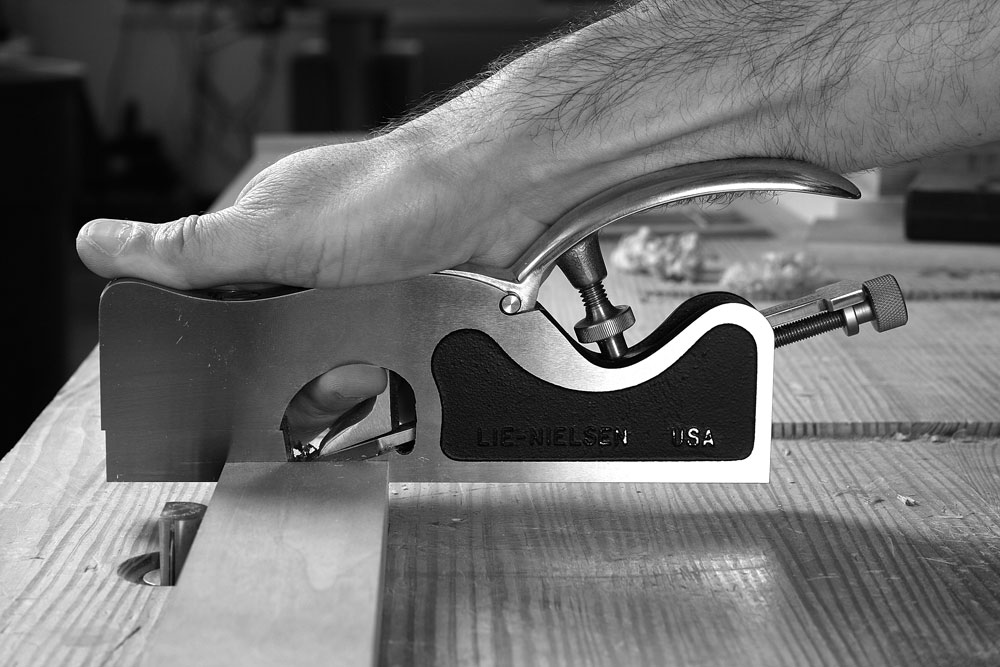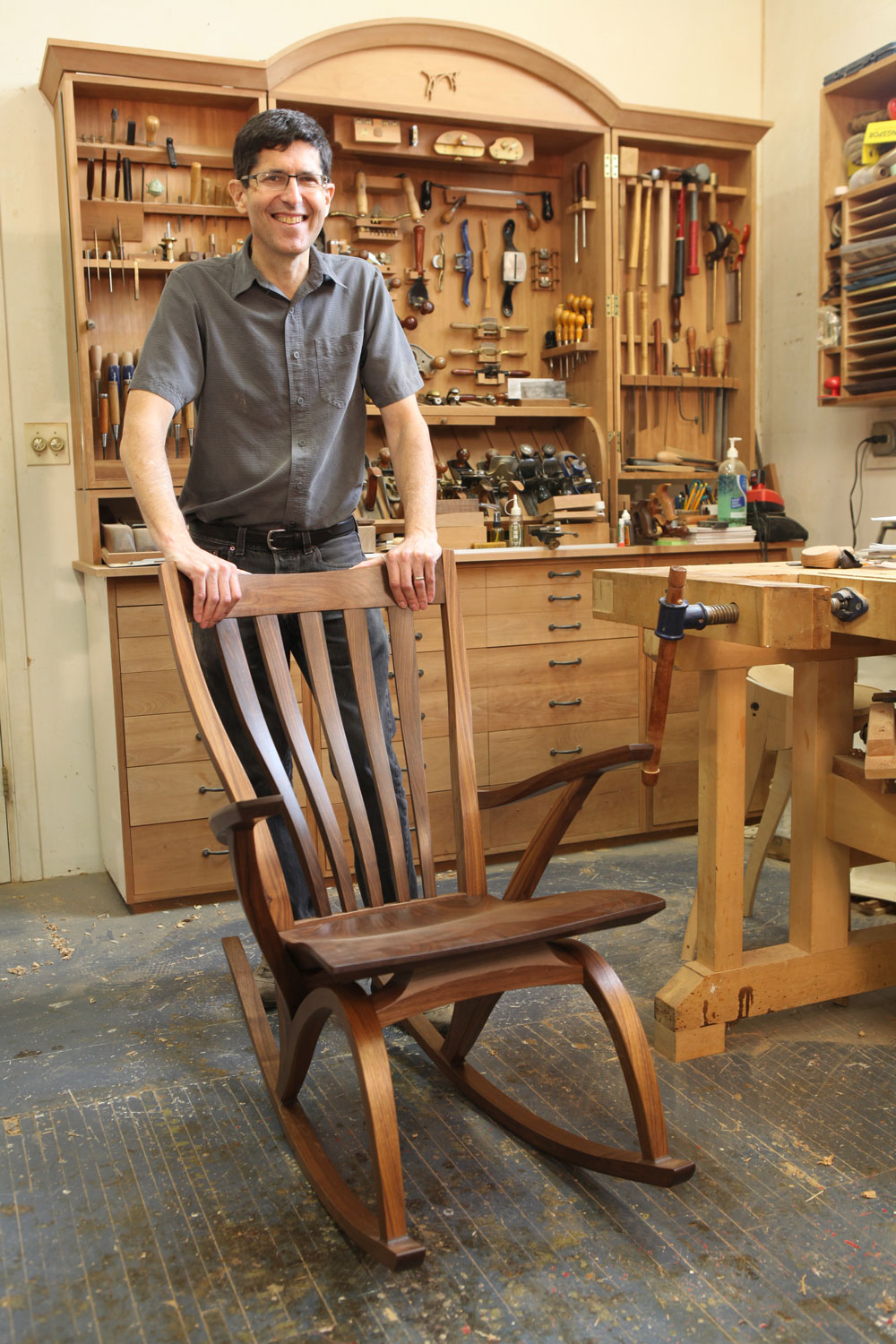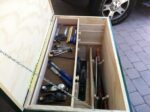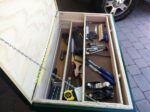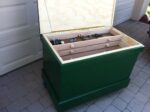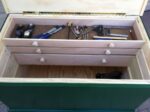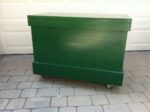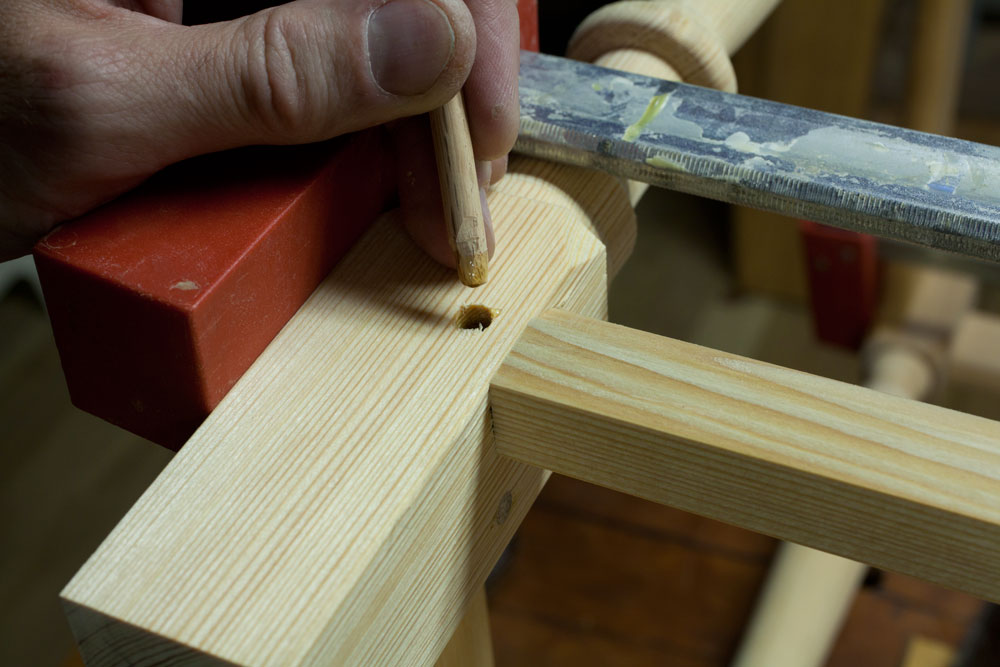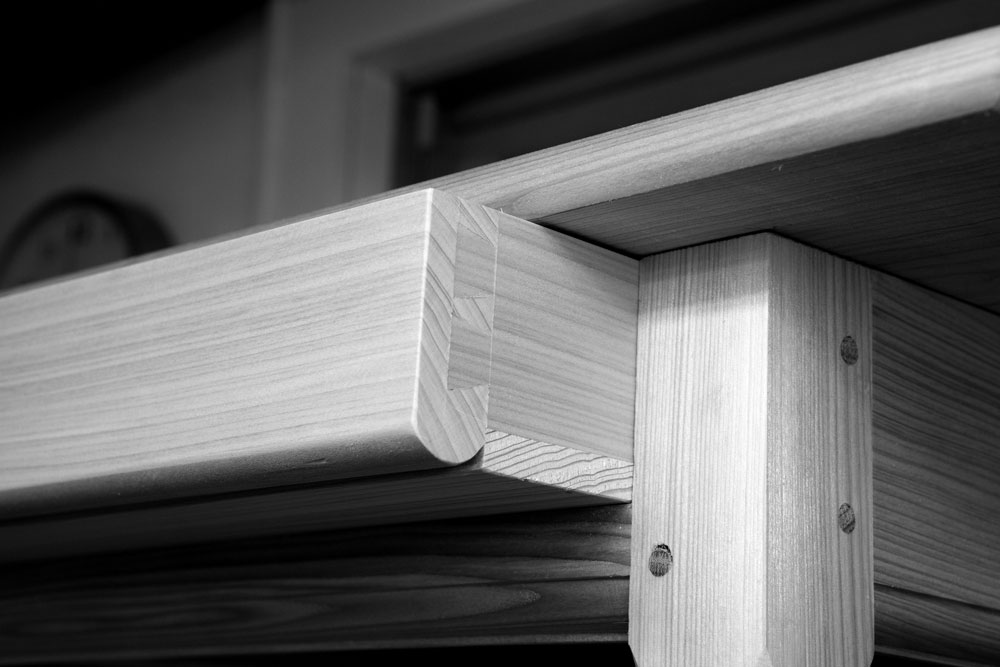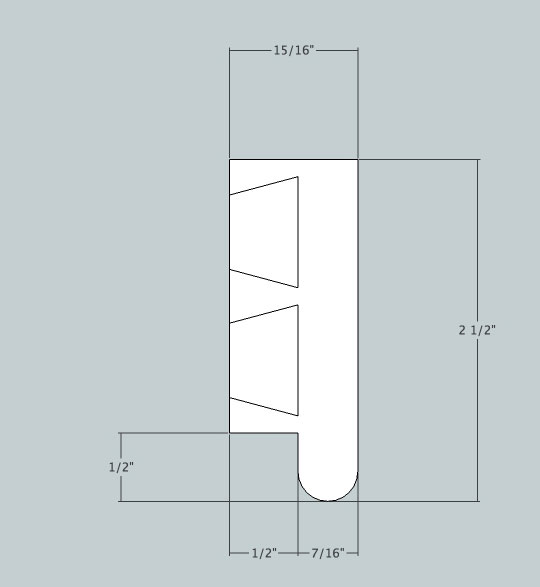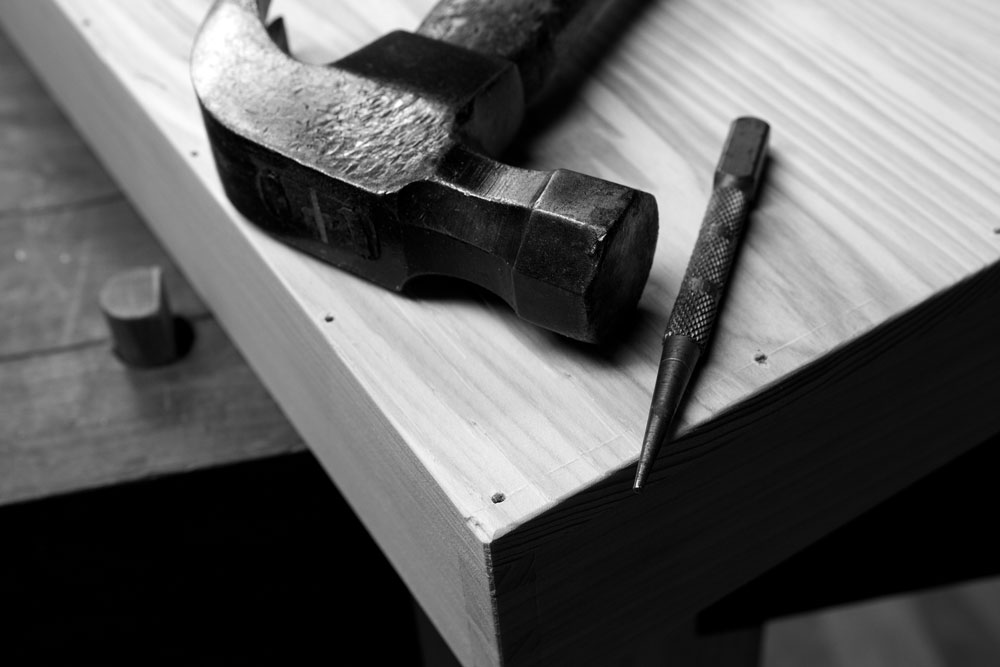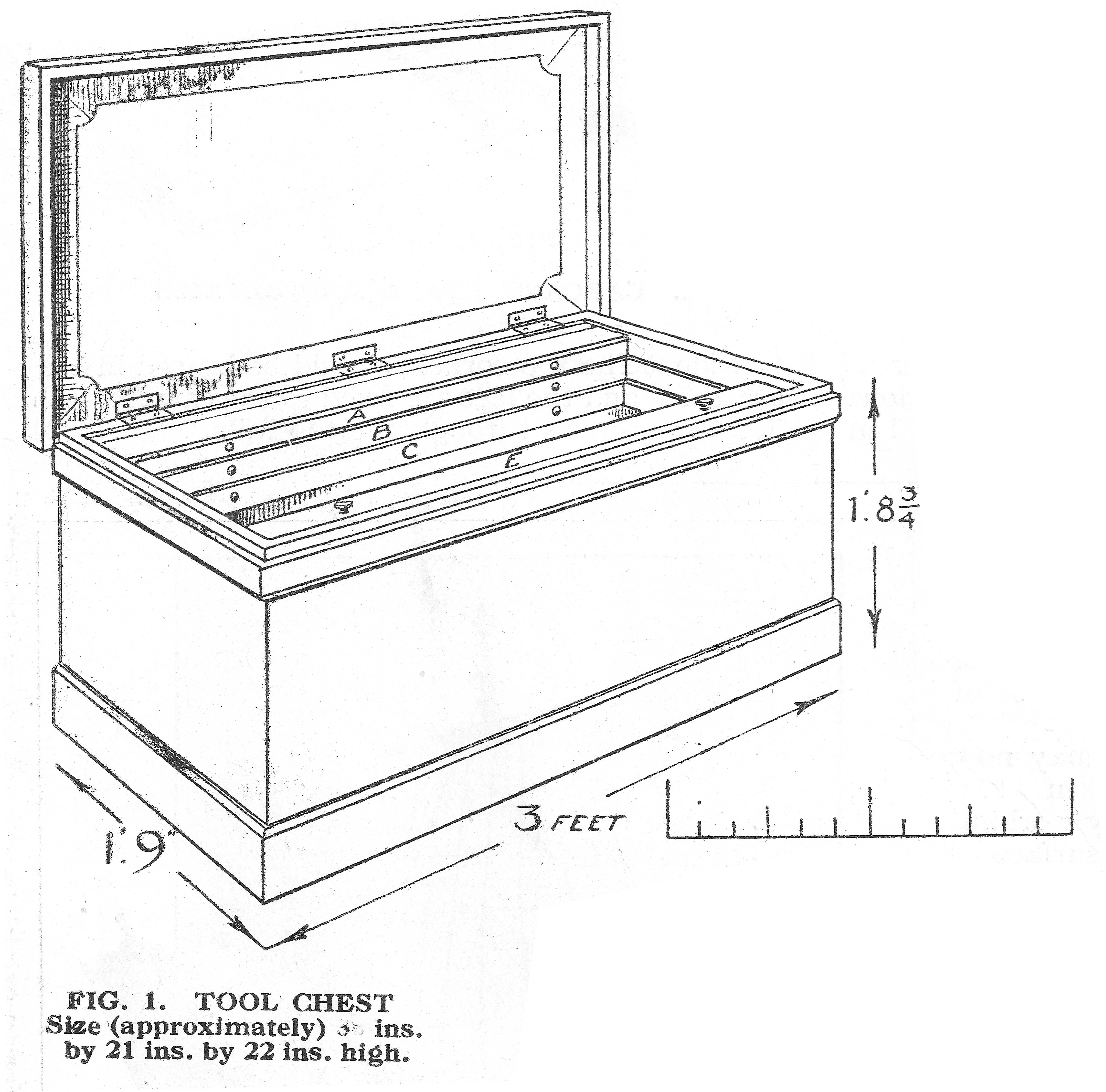
TOOL chests are still in constant demand: if not frequently, at least steadily. It is curious, too, that no matter what the woodworker may subsequently execute, nothing affords him greater pleasure than the making of a really good tool chest for his own use. The one shown here makes no claim to being a work of art. Its two merits are its all-round usefulness and its lasting strength.
From Fig. 1 (and more particularly from the sectional elevation, Fig. 2) it will be seen that there are three drawers, or tills (A, B, G), which slide forwards and backwards on runners. The top drawer has a hinged lid (D). The saw till (E) slides up and down inside the front of chest, At Fig. 2 it is shown slightly raised.
The carcase may be of clean white deal. Yellow pine would of preferable, but the price may be considered prohibitive. The fittings of the original chest described were of mahogany, the inside of the lid being veneered. Plain hardwood used for the fittings must be of the best quality. The over-all measurements suggested are about 3 ft. long by 1 ft. 9 ins. wide, and about 1 ft. 10 ins. high to top of lid. These sizes are approximate, and, after the worker determines his carcase length, width and height, the other parts can be made accordingly.
For the front and back two pieces (approximately 3 ft. by 1 ft. 8 ins., and 3/4 in. thick) will be jointed up to obtain the width. For the ends two pieces about 1 ft. 9 ins. by 1 ft. 8 ins. (also 3/4 in. thick) are required. These four sides, after squaring up, are dovetailed together, the dovetail pins being about 2-1/2 ins. apart. Before glueing, trench both ends to take a length of stuff 4 ins. by 1/2 in. (F, Fig. 2). This forms compartment G (Fig. 2) for moulding and beading planes.
The bottom, which will be screwed on, is of 3/4 in. tongued and grooved boards, the boards running from back to front of the chest (not lengthways). Level the edges and mitre and sprig on the bottom plinth (H), 4-1/2 ins. high, with a 1/2 in. ovolo moulding. The top plinth (J), 2-1/2 ins. wide, can be similarly fixed, keeping it down 1/2 in. from top edge.
Around the top edge of chest it is wise to glue and sprig a mahogany slip, 3/4 in. by 1/2 in., mitred at the corners Level it inside and outside. A good lock will complete the carcase.

FITTINGS — These may of course be varied to suit individual requirements, but the suggestions here apply to the average kit. Reference has been made to the compartment G (Fig. 2) for moulding planes. Alongside this is a larger compartment (K) for bench planes. For covering these compartments a sliding board is provided (L, Fig. 2). This board will be 10 ins. wide by 1/2 in. thick, and should be clamped at both ends to prevent twisting. When drawn to the front of the chest it covers the compartment K. To provide a bottom runner for this sliding board, two pieces (preferably of mahogany) in. square are glued and sprigged to the ends (see M, Fig. 3). These, standing 9 ins. from the bottom, are stopped 2 ins. from the front of chest to allow for the rising saw till (E).
The three drawers (or tills) are seen in Fig. 2 and enlarged in Fig. 3. For the bottom runners of the third till (C) two pieces 1-1/2 ins. by 1/2 in. are required (N, Fig. 3). They are screwed to the edges of two pieces 3-1/2 ins. by 7/8 in., which in turn are screwed to the ends of chest above the sliding board, allowing the latter freedom to slide to and fro. Above these, two pieces 3 ins. by 5/8 in. are similarly fastened. Fig. 3 makes this clear. All the runners must stop exactly 2 ins. from front of chest to allow the saw till to be inserted.

THE TILLS (Fig. 3) are 8 ins. wide and respectively 2-1/2 ins., 3 ins. and 3-1/2 ins. deep, dovetailed together, the lap-dovetail being used on the fronts. For the fronts 1/2 in. mahogany is an advantage; the sides, backs and bottoms may be of good white deal, finishing at 3/8 in. The bottoms are not grooved in; the till fronts are rebated and the bottoms screwed on, the screws being countersunk. The upper till may have a 3/8 in. or 1/2 in. mahogany top, hinged to open as a lid. The top till may be divided into four equal compartments, the second into three and the bottom one into two.
SAW TILL (see E, Fig. 2). — This is really a shallow tray (2 ins. deep, outside measurement) fitted vertically. It runs the entire length (inside), but is 1/2 in. less than the height of the chest. In Fig. 2 the till is shown slightly raised. In it are hung, by means of slots and turn-buttons. the hand, tenon and dovetail saws and the large square. The top should be of mahogany, 3/4 in. net, the remainder being of white deal. The back may be grooved in. The drawer runners hold the saw till in position.
LID — If to be veneered inside as suggested, the lid should be of good yellow pine, free from knots, 7/8 in. thick net (deal is of too resinous a nature to take kindly to veneer). It should be clamped at both ends to prevent twisting, and then squared up to about 1/16 in. larger than the chest all round, to allow for subsequent fitting. It is now toothed on the inside, and a piece of curly Spanish mahogany veneer laid to within about 2-3/4 ins. from the edges. When dry, the veneer can be cut all round with the cutting gauge set to 3 ins., and the waste removed. Next, with the compass set to 2-1/2 ins., mark off the comers, cut with a sharp penknife, and remove the veneer; this can easily be done with a chisel after the application of a hot smoothing-iron. The margin is of walnut veneer, crossbanded, i.e., the grain running the short way, butted up against the mahogany veneer; the comer pieces are made in two mitres. If preferred, the comers may be left square, and the margin simply mitred.
When dry, the veneers can be cleaned off, and the lid properly fitted; it is then hung with three strong brass butt-hinges. A rim is mitred round the edge of lid to shut down on the top plinth; the joint may be broken by a 1/8 in. bead.
It only remains to have the inside of the lid and all mahogany parts french polished, and the white wood stained mahogany colour. Small knobs can be fitted to the three drawers and saw-till.
— The Woodworker, 1936
Like this:
Like Loading...

